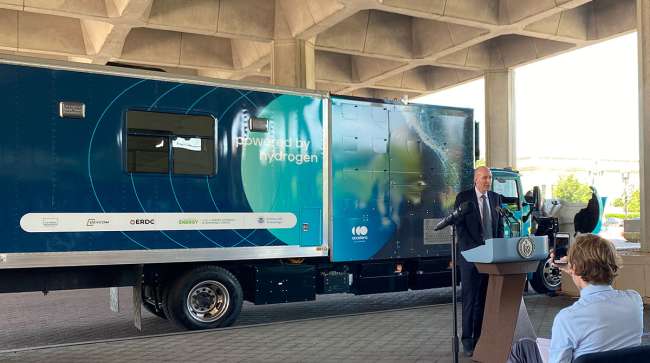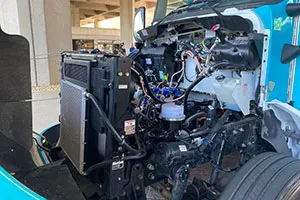Staff Reporter
Cummins Showcases Emergency Truck Powered by Hydrogen

[Stay on top of transportation news: Get TTNews in your inbox.]
WASHINGTON — Accelera by Cummins on June 5 showcased a hydrogen-powered emergency vehicle that advances technologies applicable to the commercial trucking industry.
The H2Rescue was designed around disaster-relief scenarios. The vehicle can complete a 180-mile round trip to disaster sites to provide supplies, power, heat and water, and can act as a communications center.
Accelera showcased the vehicle alongside its government partners during an event at the U.S. Department of Energy.
“Today is an exciting milestone for Accelera as we wrap up this vehicle roadshow demonstrating the applicability of hydrogen technology for emergency vehicle applications,” said Alison Trueblood, general manager of hydrogen at Accelera. “We are excited to demonstrate that this technology really can apply in a broad range of applications.”
The wait is finally over. Our next breakthrough is here! #Cummins #AccelerateTheShift pic.twitter.com/iiJZF5W0Qo — Cummins Inc. (@Cummins) March 8, 2023
The H2Rescue takes a modular approach to its battery configuration. The vehicle has an Accelera 90-kilowatt fuel cell engine and a 250-kW traction motor. It carries 175 kilograms of onboard molecular hydrogen. The vehicle can power up to 25 emergency trailers for three days.
Trueblood noted this technology has direct applicability to commercial trucking.
“This unit itself has two 45-kW fuel cell modules to create 90 kilowatts of power,” Trueblood said. “We are taking a building block approach in our product strategy. We offer a 30-kilowatt, a 40-kilowatt, a 45-kilowatt, which we can stack on top of one another to create the right power range. As we look forward now to where we think the industry is going in terms of the requirements, for Class 8 heavy-duty trucks for example, we think that’s going to be more in the 150- to 300-kilowatt range.”
Trueblood added that 300 kilowatts of power usage could take the form of two 150-kilowatt fuel cell power modules configured together like building blocks and expects the 150-kilowatt power module to be launched in early 2025. She noted the focus at the moment is on creating vehicles that demonstrate technologies to better understand where improvements can be made in terms of reliability, durability and efficiency.

Trueblood
“It gives quite a bit of flexibility when we think about ease of integration and taking the existing chassis to reduce OEM costs over time,” Trueblood said. “We have certain envelopes where we fit technology today, and ideally over time we’d be able to improve and fit our technology into those same existing envelopes, which is another advantage of this modular approach.”
Accelera was launched March 8 as a new brand aimed at accelerating the transition to sustainable energy solutions for commercial applications. Cummins sought to bring together the many different sustainable energy projects it had been working on. The H2Rescue project, for instance, started with a government funding grant in September 2020.
“What’s been exciting about Accelera as we mentioned during the initial launch is we’ve acquired eight startups over the course of the last several years,” Trueblood said. “Bringing all of those startups together under one umbrella and giving us our own cultural identity within Cummins has really been a big milestone for us as a company.”
The event included representatives from several government offices who have supported the project as part of an interagency collaboration to advance hydrogen fuel. That group includes DOE, the U.S. Army Ground Vehicle System Center, U.S. Army Corps of Engineers, the U.S. Department of Homeland Security and the Federal Emergency Management Agency.

View of the hydrogen fuel cell engine on an H2Rescue truck. (Connor D. Wolf/Transport Topics)
“It’s terrific to be here for the unveiling of our H2Rescue truck,” DOE Deputy Secretary David Turk said. “This is a three year effort in the making. This is a mark of our technological and our interagency and our public and private partnership progress. And it’s also one of the many achievements that we’ve had in this interagency working group. And I really want to thank our interagency partners.”
Turk called the emergency vehicle unveiling a milestone in interagency efforts to advance hydrogen fuel. He also applauded Cummins for focusing on hydrogen technologies and developing the vehicle.
“This truck will be a lifeline to communities desperately in need of one,” Turk said. “It delivers enough electricity to power an emergency shelter for three days, so three whole days of an emergency shelter being powered up when and where that power is needed the most. It can provide water and stores food and first-aid supplies, and incredibly important in any emergency situation, serves as a communications hub for emergency responders.”
Want more news? Listen to today's daily briefing below or go here for more info:

